Many of us wouldn’t associate stormwater with pollution. Quite the opposite: When it rains, we picture the Earth’s soil nourished, depleted lakes and ponds replenished. But what we do on land—how we care for and maintain it—ultimately affects our waters. Felling trees, dumping waste, saturating crops with pesticides are but a few ways urban development has altered the natural water cycle.
Think about it: With so many pollutants lingering on land, and with fewer native plants and trees to create buffer zones during storms, waste has to go somewhere. And it’s often down stormwater drains, into wetlands, headwaters and streams. The results are troubling: imperiled, if not destroyed, freshwater ecosystems and contaminated drinking water. Additionally, the disinfectants used to treat water pollution contain harmful chemicals known as dioxins, byproducts that, when consumed, can cause problems with development and reproduction.
The Impact of Landscaping
Here’s another myth debunked: fertilizer, applied to lawns by dutiful homeowners, is one of the leading causes of water pollution. In fact, more than half of Florida’s waterbody impairment comes from excess fertilizer washed down storm drains. According to the Florida Department of Environmental Protection, which sets regulated water quality standards on rivers, lakes and streams, a waterbody is deemed “impaired” if it’s “in need of restoration.” This means the state must levy heavier taxes on residents to remediate the damage. In Seminole County, for instance, the department estimates that it costs taxpayers $3,500 to extract a pound of nitrogen from surrounding lakes.
To help put the issues of stormwater runoff and waterbody impairment into perspective, IDEAS For Us focused its September Hive on sustainable landscape practices. The event featured guest speakers Tina McIntyre and Tia Silvasy, landscape agents with the University of Florida’s Institute of Food and Agricultural Sciences. They explained that while fertilizer does indeed contain organic compounds essential to plant growth, there can be too much of a good thing. Making a dent in Florida’s impaired waterways requires not only understanding the causes and effects of water pollution, but implementing simple measures to mitigate it.
Believe it or not, it starts with your lawn.
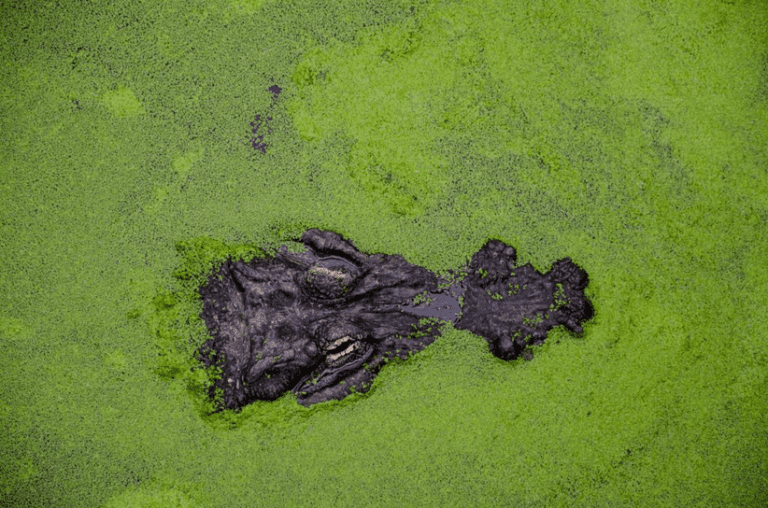
Toxic blue-green algae cloaked Lake Okeechobee, once a sought-after recreation spot, for nearly a year. The outbreak was so severe that in 2018 former governor Rick Scott declared a state of emergency in seven counties. Photo: Patrick Wittke/Unsplash
Florida's Waterway Crisis
Over the past decade, a pervasive enemy has invaded Florida’s rivers and streams. Sluggish, smelly, florescent green—it’s one of the biggest threats to wetlands and wildlife, able to kill fish and choke waterways for miles. This slime-emulating foe, of course, is algae, and it’s wreaking havoc on the aquatic systems that supply our drinking water and sustain habitats for native species.
Although Florida’s toxic algal blooms have been well-documented, they are increasing in frequency and encompassing larger swaths of geographic regions. Last October, in the longest-lasting algal bloom recorded in over a decade, a red tide seized approximately 145 miles of Florida’s southwest coastlines. Though red tides are common to Florida—typically occurring every year, between October and April, dating back as far as the 1500s—the ones that have emerged recently are unprecedented, more resilient and deadly.
Composed of phytoplankton known as dinoflagellates, the alga itself isn’t red, but when amassed in great numbers, it gives the appearance of a red or golden hue. One dinoflagellate, Karenia brevis, is particularly menacing, producing a neurotoxin that impairs neurologic and muscle function in those who ingest it. The hardest hit from the red tide, not surprisingly, was marine life. Thus far, more than 300 sea turtles have died, as well as thousands of fish and at least 100 manatees.
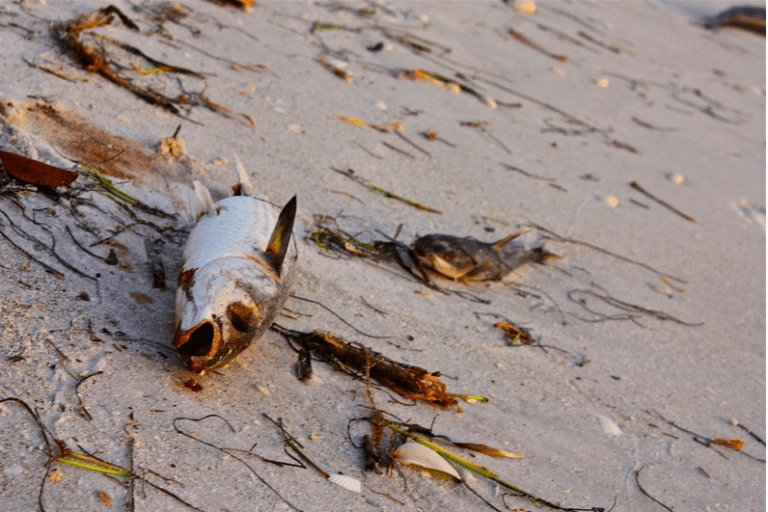
Fish washed ashore on Sarasota Beach during an outbreak of red tide in October 2017.
Breaking the Natural Cycle: Stormwater Runoff
What causes these outbreaks, and why have they gotten out of hand? It starts—where else?—with human activity. Decades of discharging fertilizer, sewage and chemicals into our waters has led to excess levels of nutrients, spurring toxic algal blooms. Lake Okeechobee—infamous for its proliferating blue-green algae—has long been the dumping ground for nearby industries and residential communities. The lake’s pollution also contributes to red tide; as algae decompose and die, they release nutrients into the water that feed phytoplankton. This abundant nutrient availability, combined with increasingly warming temperatures, creates an ideal breeding ground for algae populations to explode (a process called eutrophication) and prosper.
While industrial agriculture and climate change have certainly stoked algal blooms, some environmental hazards can be found in our backyards. Literally. Trash, grass clippings, pet waste, improperly fertilized lawns, pesticides—all play a role in polluting surface water. One of the biggest concerns of runoff is that it disrupts the natural water cycle, creating less opportunity for water to infiltrate soil, where it goes through an organic filtering process and replenishes aquifers (which are already compromised in Florida).
Part of maintaining this cycle involves preserving our watersheds—land areas that channel rainwater into smaller waterbodies, and eventually to outflow points such as estuaries, lakes and oceans. Excess fertilizer, nonnative plants near shorelines and urban developments that create impervious surfaces—roads, parking lots, for example—have sinister effects on watersheds. Having nowhere to go, water runs off these land surfaces and directly into storm drains. Less water infiltration also means more flooding, as waterbodies can handle only so much water volume.

Illustration of a watershed and the natural rain cycle. Photo: Dazeys Supply
But treating runoff is more complicated than eliminating nutrients from groundwater. While we can point to a vehicle or factory and know the culprit of pollution, pollutants in runoff can’t be traced directly back to their source. Silvasy elaborated on this distinction, between point source and nonpoint source pollution, in her discussion at the Hive. Whereas point source pollution comes from a single identifiable source—smokestacks, ditches, sewage plants—nonpoint pollution results from an array of sources. Four of the most common include nutrients (nitrogen and phosphorus), bacteria (pet waste), sediment (eroded soil particles) and toxic organics (oil and pesticides). Silvasy explained that nonpoint sources are responsible for most of the waterbody impairment throughout Florida. That they are inconspicuous and untraceable makes them all the more difficult to manage.
Healthy Lawns, Healthy Waterways
The latest buzzword in eco-friendly landscape management is “low impact development.” Low impact development, or what the Environmental Protection Agency calls “green infrastructure,” employs practices that recreate natural landscapes, harvest rainwater by reducing the number of impervious surfaces on land, and treat stormwater as a vital resource rather than a pollutant. According to the EPA, low impact developments, whether large- or small-scale, can manage water “in a way that reduces the impact of built areas and promotes the natural movement of water within an ecosystem or watershed.” Citing low impact development’s principles, Silvasy and McIntyre related that the best way to prevent stormwater runoff is to keep water—and subsequently, fertilizer and grass clippings—in your yard. Here are five of their suggested “best management practices” for improving waterfronts and maintaining healthy lawns.
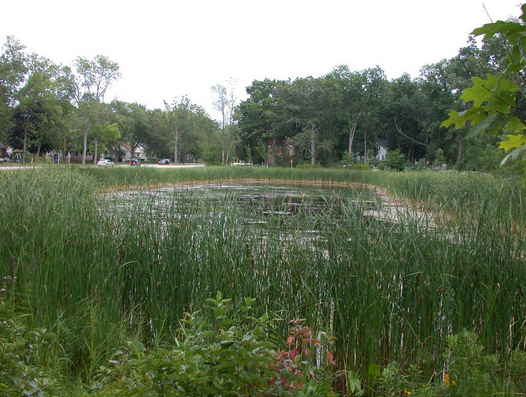
Photo: Flickr
Stormwater Ponds
As noted by Silvasy and McIntyre, stormwater ponds “are our first line of defense.” They capture stormwater runoff and suspend nutrients, letting them percolate and settle deep into the soil. Littoral plants help absorb these nutrients and provide a buffer against harmful compounds leached from stormwater. Silvasy and McIntyre’s motto: the right plant, for the right place. They also instructed not to mow within 10 feet or more of shorelines, as it can cause soil erosion. “If you have the option to buy native plants and integrate them into the littoral zone of the stormwater pond, that’s ideal,” McIntyre said. “But even if you can’t, just stop mowing.” To build your own stormwater pond, refer to this how-to guide: https://www.hunker.com/13424245/how-to-create-a-retention-pond-for-water-runoff.
Downspouts
As many homeowners know, rainwater can collect on rooftops, causing significant damage over time. More disconcerting, however, is the atmospheric nitrogen lurking within rainwater, a result of fossil fuel emissions and nitrogen-containing fertilizers. Redirecting downspouts over vegetation instead of pavements prevents harmful runoff. Better yet, position your downspouts near low impact developments, such as rain barrels (vessels for harvesting rainwater) or rain gardens (porous landscapes that act as sponges for nutrients) so that atmospheric nitrogen has somewhere to go, other than stormwater networks. For more information on adding downspouts to your home, see https://www.hunker.com/12268002/how-to-add-a-downspout-in-an-existing-gutter.
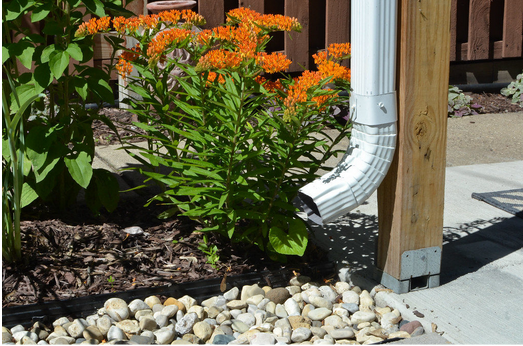
Photo: Flickr
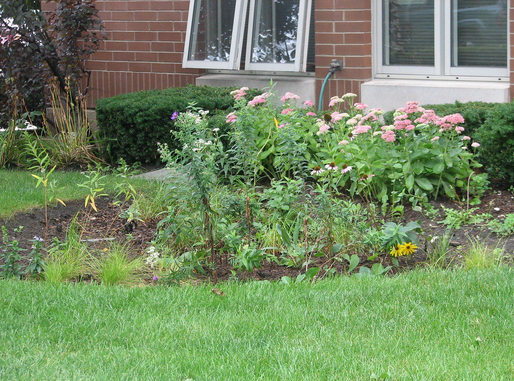
Photo: Flickr
Rain Gardens
Want to spruce up your lawn while helping the environment? Rain gardens are designed to capture stormwater refuse, including pesticides and fertilizer, before they reach drainage networks. Along with providing municipal benefits and adding to a home’s aesthetic beauty, rain gardens contribute to uptaking and filtering water, allowing any excess to soak into the soil, where it recharges aquifers. While planting a garden may seem an insignificant solution to a large-scale problem, collectively they can reduce nutrient loading in waterways by 30%. Two factors contribute to a successful rain garden: positioning the garden near a downspout, driveway or sump pump to catch rainwater runoff, and choosing perennial native plants that are drought and heat tolerant. For a comprehensive list of plants suitable for rain gardens, visit https://extension.psu.edu/rain-gardens-the-plants.
Rain Barrels
Harvesting rainwater improves the health of your lawn and protects the environment by preventing stormwater runoff. It also saves you money. As McIntyre mentioned in her presentation, it takes 20 rain barrels to collect one pound of nitrogen per year—far cheaper than the $3,500 Seminole County residents pay in additional taxes to blunt the effects of water pollution. On a smaller economic scale, they also provide the Florida homeowner with 40 gallons of free water each time one fills up. You can connect additional rain barrels or install an underground cistern for more storage. McIntyre suggests connecting a hose to the barrel’s overflow port and directing the water at least six feet away from the building’s foundation. Make sure the water flows onto vegetated areas, like turf and landscape beds. To learn more about rain barrels, visit https://ffl.ifas.ufl.edu/materials /RainBarrels101.pdf.
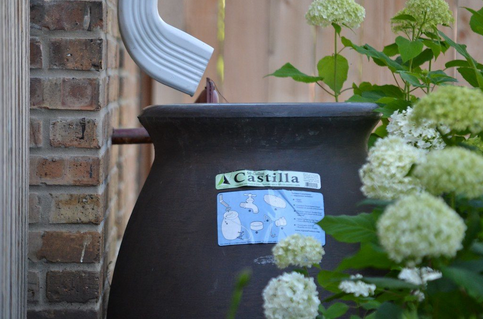
Photo: Flickr
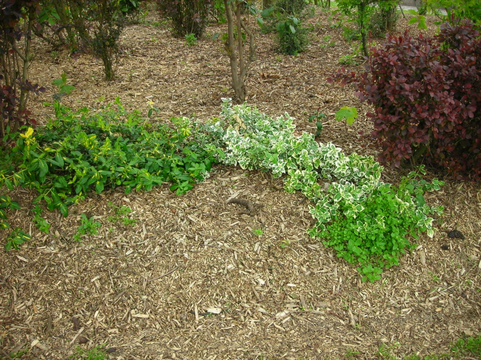
Photo: Wikimedia Commons
Mulch
Mulch not only improves the quality of your soil by breaking up clay and allowing for better circulation, but also provides nutrients that enhance its ability to hold water longer. Think of mulch as an insulating blanket: It traps moisture, keeps soil cool during summer months and stores excess nutrients in soil. When organic matter washes down storm drains, McIntyre noted, “we miss out on a compost opportunity.” The average home generates more than 400 pounds of grass clippings per year. Instead of leaving them on pavements, which is illegal in most counties, use them as compost and mix it with mulch.
Concluding the IDEAS Hive, McIntyre maintained that these simple management practices have far-reaching effects on eliminating nutrient loading and subsequent algae bloom. Too often, we dispose of unwanted materials slapdash, not taking into consideration the delicate ecosystems they destroy. McIntyre urged residents to think about low impact developments that can be done on home turf. “I’m afraid that sometimes we trivialize these small actions,” she said, “but when added up across a community, they can have huge impacts.”
Sources
https://www.who.int/news-room/fact-sheets/detail/dioxins-and-their-effects-on-human-healthhttps://www.cleanwateraction.org/features/harmful-algal-outbreaks-and-drinking-waterhttps://floridadep.gov/dear/watershed-assessment-section/content/assessment-listshttps://www.ncbi.nlm.nih.gov/pmc/articles/PMC2683401/https://www.miaminewtimes.com/news/report-floridas-algal-bloom-problems-will-only-get-worse-with-climate-change-11235732https://www.forbes.com/sites/priyashukla/2018/08/10/why-is-florida-experiencing-its-most-toxic-algae-bloom-in-a-decade/#1640a2dc587ehttps://ucmp.berkeley.edu/protista/dinoflagellata.htmlhttps://ocean.si.edu/ocean-life/plants-algae/what-exactly-red-tidehttps://myfwc.com/research/redtide/statewide/https://www.vox.com/energy-and-environment/2018/8/30/17795892/red-tide-2018-florida-gulf-sarasota-sanibel-okeechobeehttps://www.theguardian.com/us-news/2018/aug/20/manatee-deaths-toxic-red-tide-algae-bloom-floridahttps://www.vox.com/energy-and-environment/2018/8/30/17795892/red-tide-2018-florida-gulf-sarasota-sanibel-okeechobeehttp://www.floridahealth.gov/environmental-health/aquatic-toxins/_documents/economic-impacts.pdfhttps://www.floridamuseum.ufl.edu/earth-systems/blog/red-tide-is-expensive-heres-why/https://www.npr.org/2019/02/14/694479180/after-16-months-of-dead-fish-manatees-and-dolphins-floridas-red-tide-ebbshttps://www.miamiherald.com/news/local/environment/article214620390.htmlhttps://earthjustice.org/features/what-you-need-to-know-about-florida-s-algae-outbreakhttps://www.nature.com/scitable/knowledge/library/eutrophication-causes-consequences-and-controls-in-aquatic-102364466/https://ideasforus.org/climate-change-isnt-the-only-threat-to-ginnie-springs-nestle-plans-to-deplete-floridas-aquifers/https://www.nationalgeographic.org/encyclopedia/watershed/https://oceanservice.noaa.gov/facts/watershed.htmlhttps://www.usgs.gov/special-topic/water-science-school/science/watersheds-and-drainage-basins?qt-science_center_objects=0#qt-science_center_objectshttps://oceanservice.noaa.gov/education/kits/pollution/03pointsource.htmlhttps://www.epa.gov/nps/basic-information-about-nonpoint-source-nps-pollutionhttps://www.epa.gov/nps/urban-runoff-low-impact-developmenthttps://www.epa.gov/green-infrastructurehttps://ffl.ifas.ufl.edu/lowimpactdev.htmhttps://www3.epa.gov/region1/npdes/stormwater/assets/pdfs/AddressingBarrier2LID.pdfhttps://www.sciencedirect.com/topics/engineering/atmospheric-nitrogenhttp://ecosystems.mbl.edu/Research/Clue/air.htmlhttp://gardeningsolutions.ifas.ufl.edu/design/types-of-gardens/rain-gardens.htmlhttp://gardeningsolutions.ifas.ufl.edu/design/types-of-gardens/rain-gardens.htmlhttps://dnr.wi.gov/topic/shorelandzoning/documents/rgmanual.pdfhttps://www.cocoafl.org/255/Conservationhttp://gardeningsolutions.ifas.ufl.edu/care/planting/mulch.htmlhttps://www.sciencedirect.com/science/article/abs/pii/S0341816212002524http://www.seattle.gov/util/cs/groups/public/@spu/@usm/documents/webcontent/spu01_006285.pdfhttps://www.calrecycle.ca.gov/organics/grasscyclinghttps://www.seminolecountyfl.gov/core/fileparse.php/3302/urlt/chapter_235_solid_waste.pdf








